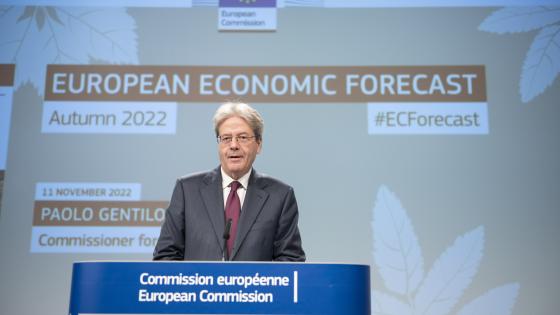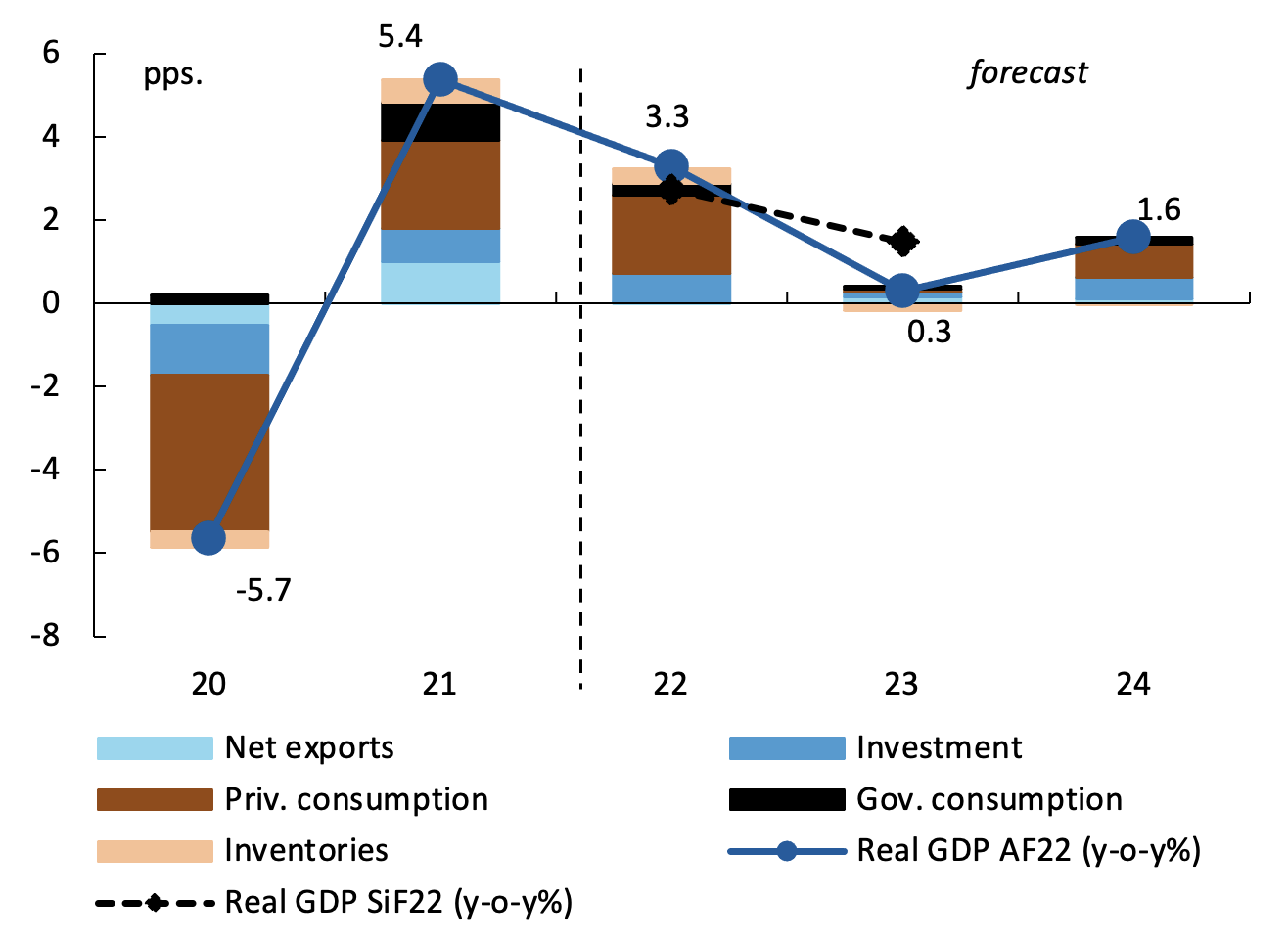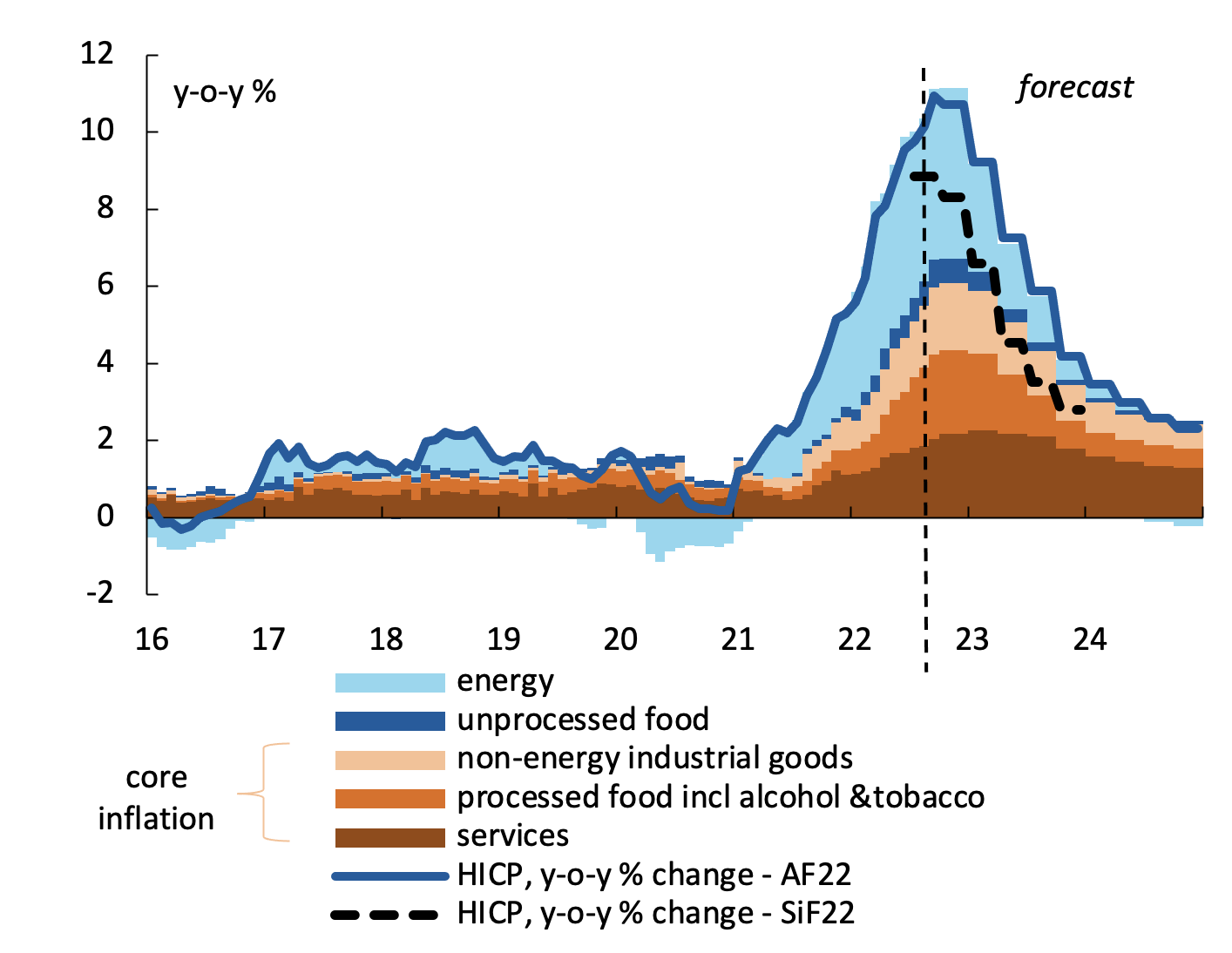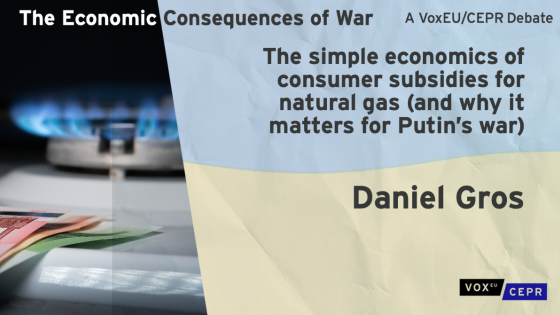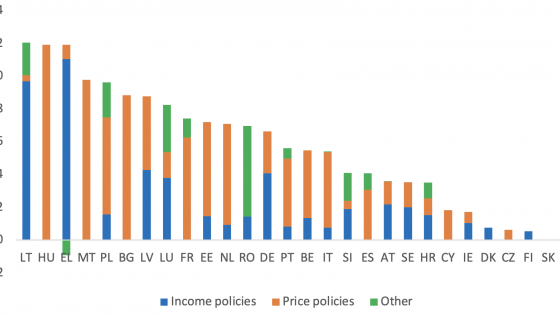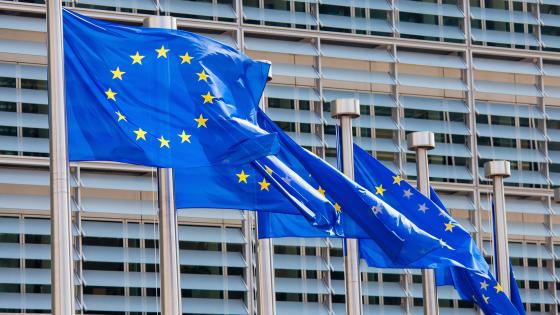The shocks unleashed by the war in Ukraine and a broad-based slowdown in external demand are taking the upper hand…
A massive terms of trade shock is making its way through the EU economy (ECB 2022a). The impact of surging energy prices is amplified by the depreciation of the euro and other EU currencies especially against the US dollar. Having largely outpaced wage growth, inflation is quickly eroding households’ disposable incomes and savings (European Commission 2022a). At the same time, exorbitant cost increases and tighter financing conditions are eating into firms’ profit margins. Economic sentiment soured over summer. As prices crept up, households were first to shift mood, heralding a downward adjustment of consumption plans. With high production costs, tightening financial conditions and demand expected to cool, business confidence also plunged, which does not bode well for investment. Furthermore, external demand is set to offer little support.Overall, the EU is likely to enter a recession this winter.
…leading to a bleaker growth outlook amid higher inflation
The EU economy continued to expand vigorously in the first half of 2022, propelled by reopening dynamics.Despite a contraction expected in the fourth quarter, real GDP growth in the EU is set to attain 3.3% for 2022 as a whole (3.2% in the euro area), well above the Summer interim Forecast (European Commission 2022b). The upward revision (+0.6 percentage points) is the result of a stronger-than-previously estimated momentum gathered until the first quarter of 2022 and the growth surprise in the second quarter. After the expected winter contraction, growth is set to gradually resume as from spring 2023 as inflation progressively relaxes its grip on the economy. However, with powerful headwinds still holding back demand, the EU economy is expected to manage only lacklustre growth, gaining some traction towards the end of 2023. Overall, annual GDP growth in 2023 is projected to attain a meagre but still positive 0.3% in the EU and the euro area (markedly less than expected in the Summer interim Forecast). For 2024, GDP is projected to grow at 1.6% in the EU (1.5% in the euro area).
The projection for inflation has been revised up significantly for 2022 and 2023 on the back of higher-than-expected inflation readings. Moreover, high energy prices keep feeding into prices of core goods and services. As price pressures broaden, they are set to be more persistent. In the EU, HICP inflation is now expected to average 9.3% in 2022, before declining to a still high 7.0% in 2023. In the euro area, inflation is projected at 8.5% in 2022 and 6.1% in 2023. For 2024, a moderation to 3.0% in the EU and 2.6% in the euro area is expected.
These projections remain subject to considerable uncertainty, and the balance of risks is skewed towards adverse outcomes as the potential for further disruptions unleashed by Russia’s invasion of Ukraine is far from exhausted.
Figure 1a EU GDP growth forecast (Autumn and Summer)
Figure 1b EU inflation forecast (Autumn and Summer)
Still, the economy displays important elements of resilience, which limit the depth of the recession and support the turnaround after the winter. A healthy and even record-tight labour market is likely to limit the impact on workers. Also, RRF spending is set to achieve high levels in 2023 and 2024, supporting not only public and private investment, but also accelerating the energy transition (European Commission 2022c). Finally, fiscal measures to offset part of the impact of rising energy prices will support domestic demand.
Fiscal measures cushion the blow to the economy, but risk being very costly to the public purse
The current economic situation puts policymakers in a difficult position. Understandably, households – and in particular those in a more precarious financial situation (ECB 2022b) – and firms in energy-intensive industries are asking governments for support.
By the cut-off date of this forecast, Member States had adopted energy measures with a net cost of close to €200 billion (1.2% of GDP, up from 0.6% estimated in Spring) for 2022 (European Commission 2022a, Bethuyne et al. 2022). Based on currently announced plans, the net budgetary cost of energy measures for 2023 is estimated at around €144 billion (0.9% of GDP). In several Member States, energy measures are planned to expire in the course of 2023 (some as early as at the end of the first quarter of the year), and, by the cut-off date of the forecast, some had not even specified any energy measures for 2023. Yet, if energy prices remain high, Member States may decide to prolong existing measures or implement new ones. As a result, for several Member States and for the EU as a whole, the budgetary cost of energy measures in 2023 may turn out to be considerably higher. Based on a simple stylised exercise, the potential additional budgetary cost of extending the energy measures to end 2023 is estimated at 1% of GDP in both the EU and the euro area, bringing the total cost of the fiscal support close to 2% of GDP in 2023, significantly higher than in 2022 (see Figure 2). What is more, the vast majority of the measures currently in place or announced are untargeted measures, which means that they apply to the majority of households and firms without (much) differentiation based on income or specific needs. Many of the measures, moreover, weaken the price signal, thereby reducing incentives to contain energy consumption and to increase energy efficiency.
Figure 2 Estimated cost of energy measures across Member States and stylised additional costs for 2023
… reinforcing the need for policy coordination
The policy space for countering this shock, however, is limited. A fiscal expansion cannot compensate for the loss ensuing from such a large terms of trade shock (Eurogroup 2022), in particular if energy prices stay high for longer. Neither is it be desirable as it would complicate the conduct of monetary policy.
Furthermore, current measures are too untargeted (and therefore costly) and tend to mute the incentives to lower energy consumption and increase energy efficiency (Gros 2022). Whereas governments recognise this in principle (Eurogroup 2022), there seems to be a gap between declarations of intentions and fiscal practices.
The fact that in many Member States these measures are set to expire in the first half of next year opens a short window to agree on a more coordinated and better calibrated approach. A careful targeting of policy interventions would protect vulnerable households and energy-intensive firms, while avoiding unintended side effects. Finally, we must use the funds provided under the RRF and its top-up REPower EU to increase energy efficiency, diversify energy supply and accelerate the development of renewable energy sources. This is the real solution to this crisis: to reduce our dependence on imported fossil fuels from Russia.
References
Bethuyne, G, A Cima, B Döhring, Å Johannesson Lindén, R Kasdorp J Varga (2022), “Targeted income support is the most social and climate-friendly measure for mitigating the impact of high energy prices”, VoxEU.org, 6 June.
ECB (2022a), Lecture by Christine Lagarde, Monetary policy in a high inflation environment: commitment and clarity, November.
ECB (2022b), “The impact of the recent rise in inflation on low-income households”, Economic Bulletin 7/2022, November.
Eurogroup (2022), “Eurogroup statement on the fiscal policy response to high energy prices and inflationary pressures”, Eurogroup statements and remarks, October.
European Commission (2022a), European Economic Autumn 2022 Forecast, European Economy Institutional Paper 187, DG ECFIN, November.
European Commission (2022b), European Summer 2022 interim Forecast, European Economy Institutional Paper 183, DG ECFIN, July.
European Commission (2022c), RepowerEU, May.
Gros, D (2022), “The simple economics of consumer subsidies for natural gas (and why it matters for Putin’s war)”, VoxEU.org, 22 September.
